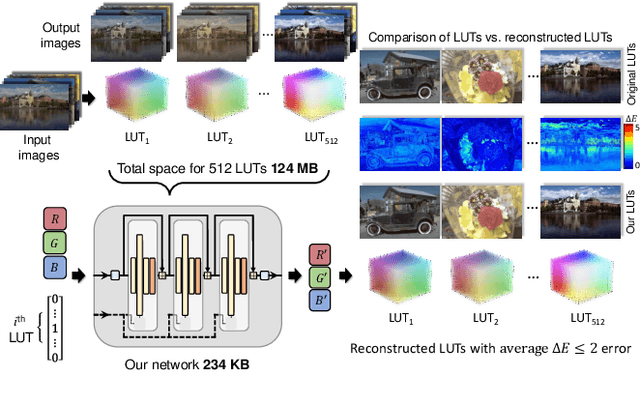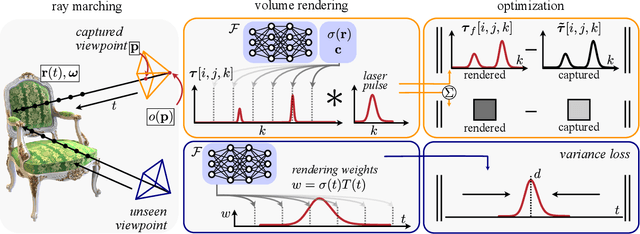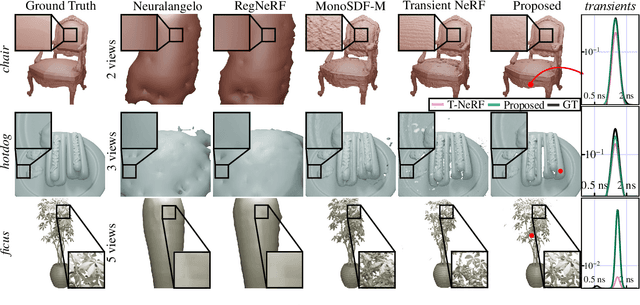David B. Lindell
MVP4D: Multi-View Portrait Video Diffusion for Animatable 4D Avatars
Oct 14, 2025Abstract:Digital human avatars aim to simulate the dynamic appearance of humans in virtual environments, enabling immersive experiences across gaming, film, virtual reality, and more. However, the conventional process for creating and animating photorealistic human avatars is expensive and time-consuming, requiring large camera capture rigs and significant manual effort from professional 3D artists. With the advent of capable image and video generation models, recent methods enable automatic rendering of realistic animated avatars from a single casually captured reference image of a target subject. While these techniques significantly lower barriers to avatar creation and offer compelling realism, they lack constraints provided by multi-view information or an explicit 3D representation. So, image quality and realism degrade when rendered from viewpoints that deviate strongly from the reference image. Here, we build a video model that generates animatable multi-view videos of digital humans based on a single reference image and target expressions. Our model, MVP4D, is based on a state-of-the-art pre-trained video diffusion model and generates hundreds of frames simultaneously from viewpoints varying by up to 360 degrees around a target subject. We show how to distill the outputs of this model into a 4D avatar that can be rendered in real-time. Our approach significantly improves the realism, temporal consistency, and 3D consistency of generated avatars compared to previous methods.
VibES: Induced Vibration for Persistent Event-Based Sensing
Aug 26, 2025Abstract:Event cameras are a bio-inspired class of sensors that asynchronously measure per-pixel intensity changes. Under fixed illumination conditions in static or low-motion scenes, rigidly mounted event cameras are unable to generate any events, becoming unsuitable for most computer vision tasks. To address this limitation, recent work has investigated motion-induced event stimulation that often requires complex hardware or additional optical components. In contrast, we introduce a lightweight approach to sustain persistent event generation by employing a simple rotating unbalanced mass to induce periodic vibrational motion. This is combined with a motion-compensation pipeline that removes the injected motion and yields clean, motion-corrected events for downstream perception tasks. We demonstrate our approach with a hardware prototype and evaluate it on real-world captured datasets. Our method reliably recovers motion parameters and improves both image reconstruction and edge detection over event-based sensing without motion induction.
Reconstructing Heterogeneous Biomolecules via Hierarchical Gaussian Mixtures and Part Discovery
Jun 06, 2025



Abstract:Cryo-EM is a transformational paradigm in molecular biology where computational methods are used to infer 3D molecular structure at atomic resolution from extremely noisy 2D electron microscope images. At the forefront of research is how to model the structure when the imaged particles exhibit non-rigid conformational flexibility and compositional variation where parts are sometimes missing. We introduce a novel 3D reconstruction framework with a hierarchical Gaussian mixture model, inspired in part by Gaussian Splatting for 4D scene reconstruction. In particular, the structure of the model is grounded in an initial process that infers a part-based segmentation of the particle, providing essential inductive bias in order to handle both conformational and compositional variability. The framework, called CryoSPIRE, is shown to reveal biologically meaningful structures on complex experimental datasets, and establishes a new state-of-the-art on CryoBench, a benchmark for cryo-EM heterogeneity methods.
Neural Inverse Rendering from Propagating Light
Jun 05, 2025Abstract:We present the first system for physically based, neural inverse rendering from multi-viewpoint videos of propagating light. Our approach relies on a time-resolved extension of neural radiance caching -- a technique that accelerates inverse rendering by storing infinite-bounce radiance arriving at any point from any direction. The resulting model accurately accounts for direct and indirect light transport effects and, when applied to captured measurements from a flash lidar system, enables state-of-the-art 3D reconstruction in the presence of strong indirect light. Further, we demonstrate view synthesis of propagating light, automatic decomposition of captured measurements into direct and indirect components, as well as novel capabilities such as multi-view time-resolved relighting of captured scenes.
Efficient Neural Network Encoding for 3D Color Lookup Tables
Dec 19, 2024



Abstract:3D color lookup tables (LUTs) enable precise color manipulation by mapping input RGB values to specific output RGB values. 3D LUTs are instrumental in various applications, including video editing, in-camera processing, photographic filters, computer graphics, and color processing for displays. While an individual LUT does not incur a high memory overhead, software and devices may need to store dozens to hundreds of LUTs that can take over 100 MB. This work aims to develop a neural network architecture that can encode hundreds of LUTs in a single compact representation. To this end, we propose a model with a memory footprint of less than 0.25 MB that can reconstruct 512 LUTs with only minor color distortion ($\bar{\Delta}E_M$ $\leq$ 2.0) over the entire color gamut. We also show that our network can weight colors to provide further quality gains on natural image colors ($\bar{\Delta}{E}_M$ $\leq$ 1.0). Finally, we show that minor modifications to the network architecture enable a bijective encoding that produces LUTs that are invertible, allowing for reverse color processing. Our code is available at https://github.com/vahidzee/ennelut.
CAP4D: Creating Animatable 4D Portrait Avatars with Morphable Multi-View Diffusion Models
Dec 16, 2024



Abstract:Reconstructing photorealistic and dynamic portrait avatars from images is essential to many applications including advertising, visual effects, and virtual reality. Depending on the application, avatar reconstruction involves different capture setups and constraints $-$ for example, visual effects studios use camera arrays to capture hundreds of reference images, while content creators may seek to animate a single portrait image downloaded from the internet. As such, there is a large and heterogeneous ecosystem of methods for avatar reconstruction. Techniques based on multi-view stereo or neural rendering achieve the highest quality results, but require hundreds of reference images. Recent generative models produce convincing avatars from a single reference image, but visual fidelity yet lags behind multi-view techniques. Here, we present CAP4D: an approach that uses a morphable multi-view diffusion model to reconstruct photoreal 4D (dynamic 3D) portrait avatars from any number of reference images (i.e., one to 100) and animate and render them in real time. Our approach demonstrates state-of-the-art performance for single-, few-, and multi-image 4D portrait avatar reconstruction, and takes steps to bridge the gap in visual fidelity between single-image and multi-view reconstruction techniques.
AC3D: Analyzing and Improving 3D Camera Control in Video Diffusion Transformers
Dec 02, 2024



Abstract:Numerous works have recently integrated 3D camera control into foundational text-to-video models, but the resulting camera control is often imprecise, and video generation quality suffers. In this work, we analyze camera motion from a first principles perspective, uncovering insights that enable precise 3D camera manipulation without compromising synthesis quality. First, we determine that motion induced by camera movements in videos is low-frequency in nature. This motivates us to adjust train and test pose conditioning schedules, accelerating training convergence while improving visual and motion quality. Then, by probing the representations of an unconditional video diffusion transformer, we observe that they implicitly perform camera pose estimation under the hood, and only a sub-portion of their layers contain the camera information. This suggested us to limit the injection of camera conditioning to a subset of the architecture to prevent interference with other video features, leading to 4x reduction of training parameters, improved training speed and 10% higher visual quality. Finally, we complement the typical dataset for camera control learning with a curated dataset of 20K diverse dynamic videos with stationary cameras. This helps the model disambiguate the difference between camera and scene motion, and improves the dynamics of generated pose-conditioned videos. We compound these findings to design the Advanced 3D Camera Control (AC3D) architecture, the new state-of-the-art model for generative video modeling with camera control.
SG-I2V: Self-Guided Trajectory Control in Image-to-Video Generation
Nov 07, 2024



Abstract:Methods for image-to-video generation have achieved impressive, photo-realistic quality. However, adjusting specific elements in generated videos, such as object motion or camera movement, is often a tedious process of trial and error, e.g., involving re-generating videos with different random seeds. Recent techniques address this issue by fine-tuning a pre-trained model to follow conditioning signals, such as bounding boxes or point trajectories. Yet, this fine-tuning procedure can be computationally expensive, and it requires datasets with annotated object motion, which can be difficult to procure. In this work, we introduce SG-I2V, a framework for controllable image-to-video generation that is self-guided$\unicode{x2013}$offering zero-shot control by relying solely on the knowledge present in a pre-trained image-to-video diffusion model without the need for fine-tuning or external knowledge. Our zero-shot method outperforms unsupervised baselines while being competitive with supervised models in terms of visual quality and motion fidelity.
Transientangelo: Few-Viewpoint Surface Reconstruction Using Single-Photon Lidar
Aug 23, 2024



Abstract:We consider the problem of few-viewpoint 3D surface reconstruction using raw measurements from a lidar system. Lidar captures 3D scene geometry by emitting pulses of light to a target and recording the speed-of-light time delay of the reflected light. However, conventional lidar systems do not output the raw, captured waveforms of backscattered light; instead, they pre-process these data into a 3D point cloud. Since this procedure typically does not accurately model the noise statistics of the system, exploit spatial priors, or incorporate information about downstream tasks, it ultimately discards useful information that is encoded in raw measurements of backscattered light. Here, we propose to leverage raw measurements captured with a single-photon lidar system from multiple viewpoints to optimize a neural surface representation of a scene. The measurements consist of time-resolved photon count histograms, or transients, which capture information about backscattered light at picosecond time scales. Additionally, we develop new regularization strategies that improve robustness to photon noise, enabling accurate surface reconstruction with as few as 10 photons per pixel. Our method outperforms other techniques for few-viewpoint 3D reconstruction based on depth maps, point clouds, or conventional lidar as demonstrated in simulation and with captured data.
VD3D: Taming Large Video Diffusion Transformers for 3D Camera Control
Jul 17, 2024



Abstract:Modern text-to-video synthesis models demonstrate coherent, photorealistic generation of complex videos from a text description. However, most existing models lack fine-grained control over camera movement, which is critical for downstream applications related to content creation, visual effects, and 3D vision. Recently, new methods demonstrate the ability to generate videos with controllable camera poses these techniques leverage pre-trained U-Net-based diffusion models that explicitly disentangle spatial and temporal generation. Still, no existing approach enables camera control for new, transformer-based video diffusion models that process spatial and temporal information jointly. Here, we propose to tame video transformers for 3D camera control using a ControlNet-like conditioning mechanism that incorporates spatiotemporal camera embeddings based on Plucker coordinates. The approach demonstrates state-of-the-art performance for controllable video generation after fine-tuning on the RealEstate10K dataset. To the best of our knowledge, our work is the first to enable camera control for transformer-based video diffusion models.
 Add to Chrome
Add to Chrome Add to Firefox
Add to Firefox Add to Edge
Add to Edge